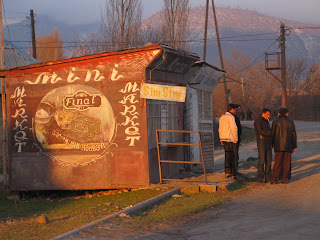 Last week of March was a holiday, so time to travel around Azerbaijan. A little tour, told in pictures, in the posts under this one... naturally, technically minded as I am, they are in the reverse order.
Last week of March was a holiday, so time to travel around Azerbaijan. A little tour, told in pictures, in the posts under this one... naturally, technically minded as I am, they are in the reverse order.Our trip took us (10 to start out with) from Baku to Ismailli
In Ismailly, one friend left, but we gained another, our host crazy enough to give us floor space to crash and join the trip
Ismailly was the base for some to explore the old village Lahij, and others to go to the last remaining Kolxoz, Ivanovka.
The next day, all of us jumped into 2 taxi's to Qebela, to fill the bus to Nic, an Udi based village that stands out for me.
The weather was great (t-shirt time), both women and men friendly, helpful and greeting us, the feel different, the location- stunning! Sites to behold apart from this incredible natural beauty are 3 old churches (2 Armenian, 1 Alban), and an old graveyard, and very nice houses with large gardens and not closed fences. The village is originally Udi, one of the orginal Alban people with their own branch of Christianity. This village has suffered lots of religious suppression, and now has a mix of animalistic and Christian beliefs, no longer practiced in the churches which are now shells. The plan to go back in May… and I am excited already. Another highlight of Nic was our lunch. In the blazing sun, pork shashliq with Tutovka, salad, bread, cheese…
Three churches in Nic, the oldest Cotari (Alban church) and two churches subject to Armenian Catholicosate in Echmiadzin: 19th century Göyűn Kilsә (situated in schoolyard, waiting for reconstruction and currently closed, interesting feather construction on the door) and Bulun Kilsә, 1890, now functioning as a shed.
From here, 2 taxies- still 10 people- were chartered to drive us to Mingeçevir (through stunning landscape!!!), where we were hosted by peace corps volunteer who lives in nearly finished, funky looking, apartment, though she sadly has to move out soon. Mingeçevir is situated at the river Kur, and it ownes its existence to the creation of a huge dam in the 1940s and the creation of a water reservoir. Apparently, most of the electricity requirements of
After the Mingeçevir tour, 8 people left back to Baki, so from the original bunch, only 3 were left. One headed back to Ismailli the next morning, while the left over original 2, together with 4 others, made our way to Yevlax for a very specific sight. After this sight and lunch, goodbyes were said, and the original 2 headed to Sheki and Kish, to stay there 1 night, and then back to Baku, tired, yet very satisfied.













































